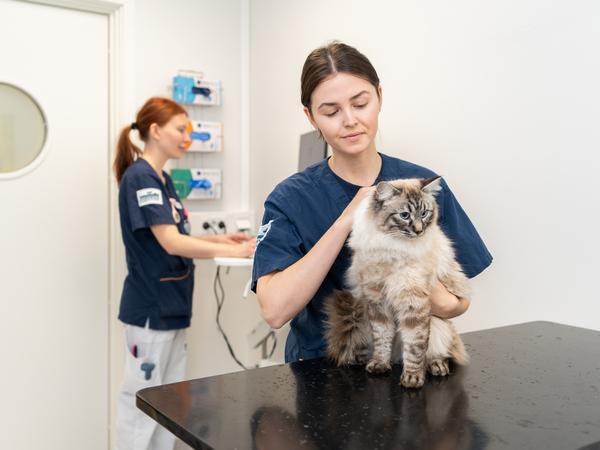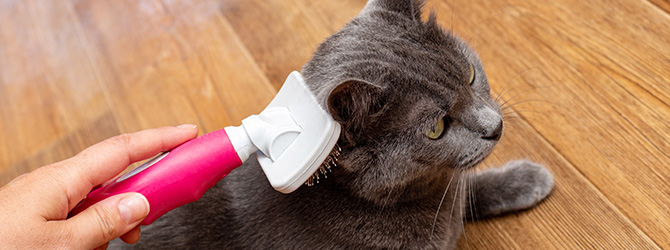Cat grooming: how to guide for cat owners
Grooming your cat is not only about keeping them looking sharp but also about maintaining their health and strengthening your bond.
The key is to prepare a comfortable grooming space and use the correct brush for your cat's fur type. Regular brushing, especially for long-haired cats, prevents mats and tangles and keeps their coat healthy.
By making cat grooming a gentle and positive experience and establishing a routine that suits your cat's needs, you’ll ensure your cat stays comfortable, healthy, and happy.
How to groom your cat
All you need to be able to groom your cat is the right type of brush for their fur type, and if they’re the type of cat that doesn’t want to be groomed, maybe a treat or two. Then just follow these simple steps
Prepare your grooming space
Choose a quiet area where your cat feels comfortable. Lay down a towel or grooming mat where you can place your cat. Have all your tools within reach so you can easily access them during the grooming session.
Brushing
Most cats will only need brushing once or twice a week, but long-haired cats may need daily brushing to prevent mats and tangles.
When brushing, be gentle and brush in the direction of hair growth. Begin at the head, then move down the body, and finish with the tail. Take extra care when brushing around the chest and belly.
If you come across mats, use a comb or mat splitter to work through them gently, being careful not to pull too hard, as this can be painful for your cat. Some stubborn mats can turn into dreadlocks. It is sometimes easier to snip these out than to hurt your cat whilst trying to untangle them.
Reward your cat
After grooming, give your cat some treats and playtime. This helps them associate grooming with positive experiences.
Remember, the key to successful grooming is regularity and patience. If your cat is new to grooming, start slowly and keep the sessions short, gradually increasing the duration as they get more comfortable.
What is the best cat grooming brush?
There are loads of cat grooming brushes available, and many people will swear that one brush is better than others, but it will generally come down to what your cat prefers.
Pin brushes
Pin brushes look like high-end hair brushes. These brushes are great for moving the oils around and keeping your cat's coat looking slick and clean but they won’t remove as much fur off your cat as others.
Slicker brushes
These brushes are great for removing dead or old fur from your cat's coat. They have thin wire bristles that can penetrate the coat more deeply, making them a good option for long-haired cats. But be careful; you can easily prick yourself on the wire bristles.
Bristle brushes
Bristle brushes are great for new cat owners or people with elderly or frail cats, as they have super soft bristles. They are also great for cats with sensitive skin as they won’t brush your cat’s skin, just the top layer of fur.
These are just three of many types of brushes, and the one you choose will most likely be a trial and error. All cats are unique, but you’ll soon be told if they don’t enjoy your chosen brush. Cats are also fickle, so have a range of brushes or combs available. What works one day might not work the next. Always brush gently, and try to keep the experience positive by using treats and praise.
How often should I groom my cat?
It depends on the breed and the time of year, but we recommend grooming your cat regularly. You should also groom your cat when they’re moulting. Use a brush with nice soft bristles, and simply brush through your cat’s fur to remove any stray hairs.
Grooming your cat is also a great chance to check for lumps, bumps, or other skin problems. Watch out for mats in your cat’s coat. This could be a sign that your cat has problems with its mouth or may have arthritis.
Common grooming mistakes to avoid
Grooming your cat is an important part of their care, but it's easy to make mistakes, especially if you're new to it. Here are some common grooming mistakes to avoid to ensure your cat remains comfortable and healthy:
Over-bathing your cat
Cats are naturally very clean and spend much time grooming themselves. Frequent baths can strip their coat of natural oils, leading to dry skin and irritation. Only bathe your cat if they are dirty, or your vet says so.
Brushing too hard
Be gentle when you brush your cat. Brushing too hard can cause skin irritation and may be painful, making your cat dread grooming sessions. Always brush in the direction of hair growth, and use the right type of brush for your cat’s fur. Your cat will tell you how hard they’ll let you brush. Some cats prefer deep, long strokes, while others prefer quick, short ones. See what your cat prefers.
Ignoring mats and tangles
Mats can be uncomfortable for your cat and, if left untreated, cause skin irritation or infections. Don’t ignore mats. If you find them, use a comb or mat splitter to work them out gently. If the matting is severe, it might be best to seek professional help from a groomer or vet.
Not checking for fleas and ticks
While grooming, checking your cat for fleas, ticks, and other parasites is important. These pests can cause serious health problems. Use a flea comb to check, and consult your vet for appropriate flea and tick prevention methods.
Forcing the grooming process
If your cat resists grooming, forcing them can make them more fearful or aggressive next time. Instead, try to make grooming a positive experience. Start with short sessions, use treats, and gradually increase the time as your cat becomes more comfortable.
Not grooming often enough
Regular grooming helps you spot any unusual signs or changes in your cat’s health early. It also helps prevent problems like excessive shedding and mats. Establish a regular grooming routine that fits your cat's needs based on their fur type and lifestyle.
Nipping their skin
While you can use scissors to cut out mats in your cat's fur, you have to be extremely careful if the mats are very bad. Vets often see cats that need stitching up because their owners cut the skin when pulling the mat down to access it. It can often be safer and easier to visit your vet and have them remove the mat with quiet, cat-friendly clippers.

By avoiding these common mistakes, you can make grooming a positive experience for both you and your cat, ensuring their coat and skin remain healthy and they feel their best.
Frequently asked questions
What’s the difference between flea dirt and regular dirt?
You might sometimes find what looks like tiny black specks in your cat’s fur or even in your carpet. This is known as flea dirt. Imagine a sprinkling of dark powder – almost like pepper. In some cases, flea dirt may be hard to tell apart from regular dirt, but there is a way. Wet a paper towel or a bit of tissue and press it against the affected fur or dirt. If they turn red, that's because they’re actually digested blood — a sure sign that fleas are around.
Why wouldn’t my cat groom itself?
If your cat is in pain or discomfort, such as due to dental disease or osteoarthritis, it may not groom itself properly. If your cat is drooling, not eating, or seems more irritable than usual, it's a good idea to visit your vet to check for any underlying issues that may be causing these symptoms.
Need advice on cat grooming?
For expert advice on grooming your cat, get in touch with your local vet.
Find your nearest vet using our Find a Vet page, or speak to a vet online using Online Vets.

